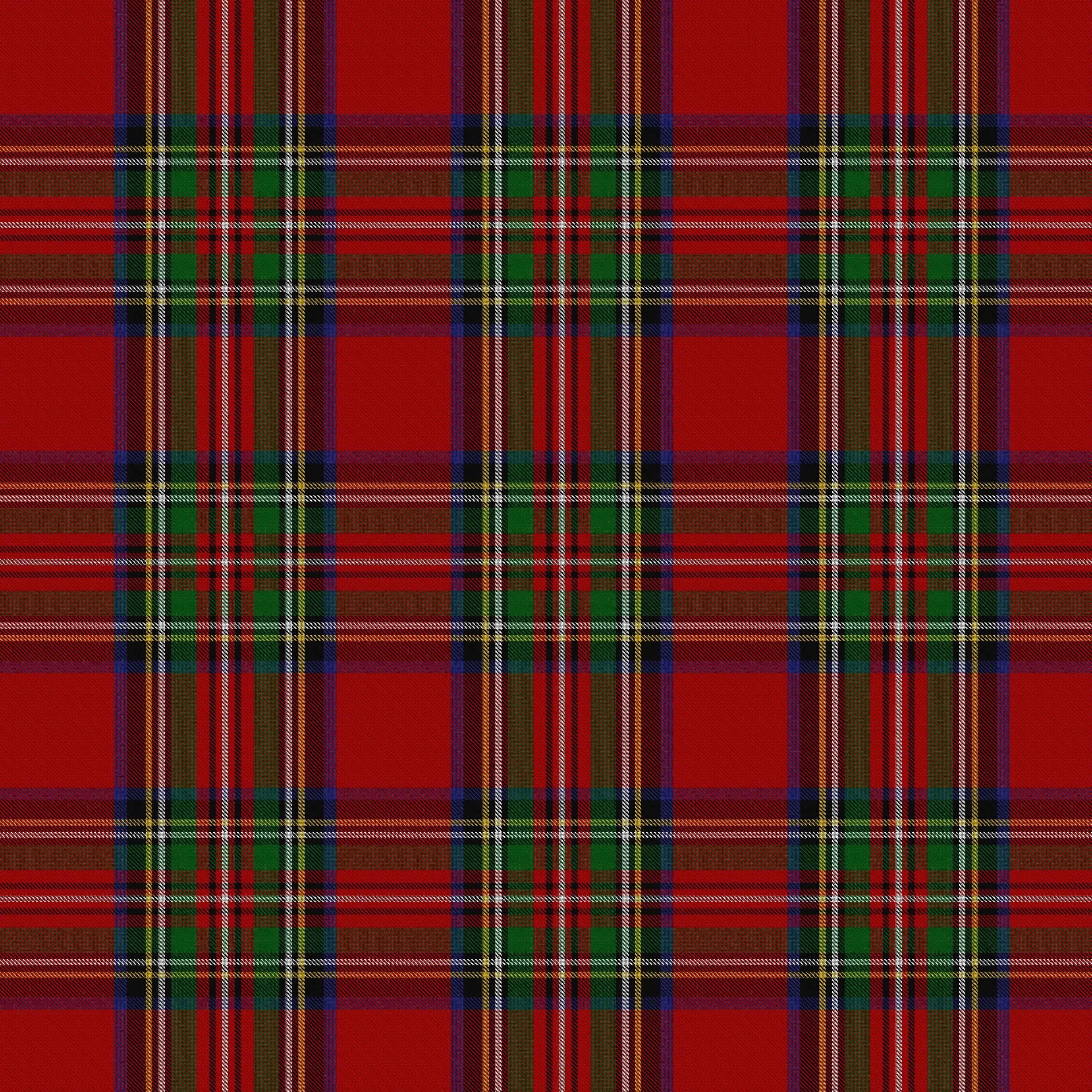Tartans as Woven Heraldry in Scotland
Monday January 15, 2024


Welcome to a vibrant exploration of Scottish heritage, where colors weave stories and patterns hold power. In Scotland, tartans are not just fabrics but emblems of identity and history, each plaid telling tales of familial bonds and ancient lands. Similarly, heraldry, with its coats of arms and crests, has been a traditional form of identity across Europe, deeply rooted in the chivalric and cultural practices of the Middle Ages.

Tartans, characterized by their intersecting horizontal and vertical bands in multiple colors, have historically denoted clan affiliations in Scotland. Each distinctive pattern is a badge of pride for Scots worldwide, symbolizing their ancestral connections and communal heritage. On the other hand, heraldry involves the design, display, and study of armorial bearings known as heraldic achievements. These symbols, strictly regulated and rich in symbolism, served to identify individuals and families, especially in contexts of battle and ceremony. For a deeper look into the history of heraldry, visit The Heraldry Society.
This blog post explains that Scottish tartans can be considered a form of heraldry. Though traditionally, heraldry is associated with the aristocratic classes of Europe and involves a formal system of rules, tartans’ symbolic and societal roles within Scottish culture suggest a broader definition of heraldry. I will argue that tartans constitute a unique heraldic tradition deeply woven into the Scottish cultural tapestry by examining the parallels in use, significance, and regulation.

Imagine walking through the Scottish Highlands centuries ago, where each person you meet wears a unique pattern of colors woven into their clothing. These are tartans, and each pattern is more than just a fashion statement—it’s a declaration of clan affiliation, a key to understanding one’s lineage and regional connections. Historically, tartans were the everyday dress of the Scots. Still, over time, they evolved into ceremonial garb associated with special occasions and symbols of pride during conflict and celebration.
Tartans are made up of horizontal and vertical bands, crisscrossing to form distinctive plaid patterns. Each clan has its own specific set of colors and lines, which are recorded and recognized officially today. For example, the MacDonald clan of their ancient roots and territorial dominance.
Today, the significance of tartans extends beyond historical clan markers. They are worn by all, Scots and non-Scots alike, as a universal symbol of Scottish heritage. Tartans appear in everything from kilts and scarves to the uniforms of Scottish regiments. They also play a crucial role in major events like weddings, where specific family tartans are worn as a sign of respect and belonging. Moreover, official tartans have been commissioned by states, corporations, and even sports teams, showing that this traditional fabric continues to weave into modern identity and culture.
Every thread of tartan has a story—a woven archive of family, loyalty, and pride. This enduring cultural significance makes tartans a compelling symbol akin to the heraldic traditions found elsewhere. For more on tartans’ history and cultural impact, visit the Scottish Register of Tartans.
Heraldry might conjure images of knights and battles, but it’s far more than just medieval pageantry. Heraldry is an ancient art and science involving the design, use, and regulation of armorial bearings, commonly known as coats of arms. These symbols were not merely decorative but served critical roles in identification, communication, and social hierarchy.

Each element of a heraldic design has a specific meaning: colors, shapes, and symbols convey information about the bearer’s identity, achievements, and status. The use of heraldry spread throughout Europe and found its way into every aspect of society. Kings and noblemen used heraldry to symbolize their authority and familial lineage, while institutions and cities adopted coats of arms to represent their heritage and governance.
Heraldry’s regulations are overseen by heraldic authorities, such as the College of Arms in England or the Court of the Lord Lyon in Scotland, which ensure that each coat of arms is unique and historically accurate. These bodies also play a role in the ceremonial aspects of heraldry, maintaining records that span centuries.
The historical importance of heraldry is not limited to Europe; variations exist worldwide, reflecting the cultural diversity and adaptations of heraldic practices. For instance, Japanese mon and Rwandan tribal symbols share similarities with Western heraldic traditions, indicating a universal human need to symbolize identity and values through art.
By understanding heraldry, we can appreciate not just the beauty and intricacy of these designs but also their profound significance in human history and culture. For those interested in exploring heraldry further, a visit to The Heraldry Society offers a wealth of resources and insights.
At first glance, tartans and heraldic symbols might seem worlds apart, yet they share fundamental similarities that underscore their importance in cultural identity and ceremony. Both tartans and heraldic symbols serve as critical identifiers for groups or families, each carrying rich, symbolic meanings that extend far beyond their visual appeal.
With their distinctive plaids, Tartans are recognizable markers of Scottish clans. Each pattern and color combination tells a story of familial ties and regional heritage, much like a heraldic shield conveys lineage and personal feats through its intricate motifs and colors. In ceremonial contexts, just as a knight might have displayed his coat of arms on his shield and banner, a Scottish chieftain or clansman wears a tartan kilt or displays a tartan banner during significant events. These practices underscore the role of both systems in marking important social and family milestones.
However, notable differences emerge when we examine the formal aspects of heraldry versus the symbolism in tartans. Heraldry is governed by strict rules and protocols dictating every detail, from colors to motifs, ensuring each element has a specific, codified meaning. In contrast, tartan symbolism is more flexible, allowing for personal and regional variations without the stringent regulations seen in heraldic design. This flexibility in tartan design reflects a broader, more inclusive approach to cultural symbolism, accommodating changes and new interpretations over time.
This comparative look at tartans and heraldry highlights their similarities and the distinct ways they contribute to cultural identity and preservation. Each, in its own right, offers a unique lens through which to view the complexities of symbolic representation in human societies.
The notion of tartans as merely patterns on fabric underestimates their deep cultural and historical significance. In Scotland, tartans are not just a part of tradition; they are emblems of identity and heritage, akin to heraldic symbols used across various cultures to denote lineage and valor. This section argues for recognizing tartans as heraldry, supported by their cultural equivalency, legal formalities, and symbolic complexity.
Tartans can be considered Scottish cultural heraldry because they perform many of the same functions as traditional heraldic symbols. Like coats of arms, which have long been used to identify families and individuals in Europe, tartans identify Scottish clans and families. Each tartan pattern is unique to a clan and worn with pride to signify one’s ancestral ties and communal belonging. At events like the Highland Games, tartans visibly demarcate clan membership, similar to how heraldic banners once identified knights and nobles on the battlefield.
The formal recognition of tartans further solidifies their status as heraldic symbols. The Scottish Register of Tartans, established by an act of the Scottish Parliament in 2008, serves a purpose similar to that of heraldic authorities such as the College of Arms in England. This registry maintains records of all officially recognized tartan patterns, ensuring that each design is uniquely associated with its respective clan, family, or institution. This legal framework protects tartan patterns from unauthorized use and underscores their importance as identifiers within Scottish culture.
The complexity of tartan patterns mirrors the intricate symbolism found in heraldic crests. Each color and line in a tartan can represent aspects of the clan’s history, geographic origins, and alliances, much like heraldic symbols communicate personal or familial stories through motifs and colors. For example, using red in a tartan might symbolize the bloodshed in clan battles, while green could represent the clan’s ancestral lands. This layered symbolism allows tartans to convey identity and a narrative of survival, resilience, and community.
By examining tartans through the lens of heraldry, we can appreciate them as more than just aesthetic elements of Scottish attire. They are vital symbols of history and identity, meticulously regulated and rich in meaning. As such, recognizing tartans as a form of heraldry acknowledges their role in Scottish culture and elevates them to their rightful place in the global conversation about cultural symbols and their significance.
While the argument for tartans as a form of heraldry is compelling, there are notable counterpoints based on the differences in regulation and symbolic specificity between tartans and traditional heraldic symbols.
Critics might argue that heraldry, with its detailed rules and codified meanings, involves a level of precision and legality that tartans do not possess. Heraldic symbols are created and controlled by authoritative bodies that ensure each element is unique and meaningful. In contrast, though registered, tartans do not have the same rigid definitions for their patterns and colors.
However, this difference in regulation does not diminish the role of tartans in representing clan identity and history, akin to heraldic purposes. The Scottish Register of Tartans does provide a formal mechanism for registering tartans, ensuring that each design is documented and protected, similar to heraldic registrations. Moreover, the symbolic meanings of tartans, while less formalized, are deeply ingrained in Scottish culture and widely recognized. The flexibility in tartan symbolism can be seen not as a lack of formality but as an adaptation to the needs and history of the Scottish people, reflecting a living tradition that evolves with its community.
In essence, while the modes of regulation and symbolism differ, the fundamental purpose of tartans—as identifiers of heritage and symbols of belonging—mirrors that of heraldry, affirming their place in the broader context of heraldic traditions.
Tartans have long served as symbols of identity and heritage, playing roles akin to heraldic symbols in traditional and modern contexts. Here are a few examples that illustrate how tartans function similarly to heraldry.
The Clan MacDonald’s tartan, discussed above, is known for its distinctive red and green patterns and has historically served as a battle standard, similar to a heraldic banner. This tartan was a rallying point for clan members during conflicts, symbolizing unity and shared heritage. The visual presence of the tartan in battle paralleled the use of heraldic symbols on shields and banners, identifying combatants and their allegiances.

In contemporary Scotland, tartans continue to embody roles typically associated with heraldry. The Scottish Police Federation Tartan, adopted by the Police Service of Scotland, is a prime example. This tartan, featuring blue, black, and white, is used in the uniforms of officers and symbolizes the authority and community bond of the police force. It functions similarly to a coat of arms, providing a recognizable symbol of service and duty.
These examples underscore the heraldic function of tartans in both historical and modern settings, demonstrating their continuing relevance as symbols of identity and allegiance.
Throughout this exploration, we’ve seen how tartans, much like heraldic symbols, serve as powerful emblems of identity and history. By comparing tartans to traditional heraldry, we’ve argued that they fulfill similar roles, symbolizing familial ties, community belonging, and even legal status through their formal recognition in the Scottish Register of Tartans. Moreover, the symbolic complexity of tartans mirrors that of heraldic symbols, with both forms of symbolism conveying deep cultural narratives and values.
Recognizing tartans as a form of heraldry broadens our understanding of what constitutes heraldic symbols and enhances our appreciation for cultural symbols worldwide. It prompts us to consider how other cultural symbols might be similarly recognized and valued, reflecting how societies express identity and continuity.
As we close this discussion, I invite you to look at the cultural symbols within your heritage. Consider their roles and meanings, whether they are woven into textiles, displayed in artwork, or embedded in rituals. How might they be seen as heraldic in their own right? What stories do they tell about your community, and how do they connect you to your history?
By broadening our perspective, we can better appreciate the richness of cultural expressions and their roles in shaping our collective human experience.